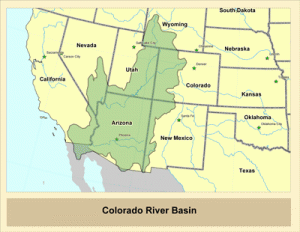Arizona Senator Jeff Flake recently embroiled water officials throughout the West in another controversy over the Colorado River. He tried to add language to a drought relief bill, which would have upset a delicate agreement affecting management of the river, substituting Congressional mischief for long-standing agreements among all seven States dependent upon Colorado River water.

Arizona and California have struggled over the “Lower Basin” share of the river for decades. But a 2014 agreement providing storage of up to 3 million acre feet of conserved water in Lake Mead helped advance the process of fair allocation.
Water levels in Lake Mead have been falling, because of the severe drought and because of federal reservoir management to benefit endangered fish. So Arizona was afraid California might take that all of that conserved water, which was banked by a number of irrigators and water districts in both States (and Nevada).
Senator Flake’s work understandably reflected the genuine concern of Arizona water providers. But new legislation dictating the uses of that water was a potential threat to all the “Upper Basin” States, too, especially Colorado – the only State still not using its entire allotment under the Interstate Compact. That always means any “excess” water in the Colorado River is potentially Colorado’s water.
There was very little chance Colorado Senators Bennet and Gardner would ever agree to a legal change affecting the Interstate Compact, at least not without complex negotiations and the agreement of all of Colorado’s major water entities.
“We’re concerned with the voluntary arrangements to store water at Lake Mead without having assurance that that water stays,” Flake told the press. But if it must “stay” in Lake Mead even during severe droughts, you may wonder, why did those water users agree to put it there in the first place? Actually, what Flake really meant was that California shouldn’t be able to get it – but that is not the way the law of the river works. Legally, the Interior Department (which manages Lake Mead) may send unused water allocations to other states within the Lower Basin, a settled part of the Interstate Compact for generations.
So Flake, frustrated in his attempt at legislation, sought instead an administrative agreement to keep this surplus water from flowing to any one state. “It’d be like having a savings account and seeing your neighbor being able to reach and grab money from it,” Flake said at a hearing last year. Well, actually, it would be more like a joint savings account where several people put money in – with an explicit agreement that it would be saved for the use of any member during tough times – and then one member trying to make sure only he had access to it.
Water that isn’t part of the various State allotments under the Compact is called “system” water, because it belongs to the whole river system, not any one State. Flake cannot specifically protect it for Arizona alone without threatening the entire system, and the delicate law on which its water allocation rests.
We understand Arizona’s concern all too well. Under the original compact, California was entitled to 4.4 million acre feet of water annually, plus any excess water during wet years, plus any unused Arizona or Nevada water. For decades when Arizona didn’t use all of its water, California was entitled to use it, and did so. But after the Central Arizona project was completed in 1994, Arizona began using all of its share. And Las Vegas had long since grown into using all of Nevada’s share, so California suddenly had a serious problem – overusing its share of the river by more than a million acre feet annually.
The other States were in a position to insist on reducing California to its entitled share, and we did so, forcing enormously expensive but vitally important conservation measures, financed mainly by Southern California’s thirsty cities. Colorado and the other States agreed to a slow ratcheting down of California’s water use (rather than an immediate shut-off), only with the understanding that measurable progress was shown. The Lake Mead agreement was a part of that long-term progress, so Senator Flake’s attempt to modify it without a general agreement, albeit it well-meaning, was a non-starter.
In the end, the right solution was finally reached: an agreement among Arizona, Nevada, California, and Interior that the government would not release the conserved water to any one State without a consensus of all three. Such comity is the only system of Western water administration that really works.
A version of this column originally appeared in the Grand Junction Daily Sentinel July 29, 2016




Comments on this entry are closed.